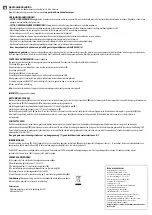
4.4 LBA
E5CK
4--9
4.4 LBA
•
The LBA (Loop Break Alarm) function can be used only when assigned
as an output. Also, the LBA function does not work when a memory
error or A/D converter error occurs.
•
LBA (Loop Break Alarm) is a function for judging that an error has
occurred somewhere on the control loop and outputting an alarm when
the process value does not change with the manipulated variable at a
maximum or minimum state. Accordingly, the LBA function can be used
as a means for detecting a malfunctioning control loop.
•
Normally, when output is set to maximum or minimum, the process
value rises or falls after the dead time has elapsed. LBA is output if the
process value does not change in the predicted direction after a fixed
amount of time has elapsed. This fixed amount of time is the “LBA detec-
tion time.”
•
LBA operation sometimes becomes unstable when the process value
fluctuates considerably due to the control characteristics. The LBA
detection width is provided so that changes with respect to output can
be correctly detected. Changes smaller than the detection width due to
LBA detection timing are not regarded as changes.
•
The following example describes what happens when a heater burnout
at maximum output.
PV
LBA=ON
LBA detection time
LBA detection width
Output
Time
Heater burnout
LBA detection time
•
LBA judgment is carried out at each LBA detection time from the point
of maximum output. In above figure, the process value (PV) is changing
greatly at the 1st judgment timing, so LBA remains OFF.
•
At the 2nd judgment timing, the process value increases as indicated by
the broken line of the process value is normal. This means that the
change width exceeds the LBA detection width, and LBA output remains
OFF.
•
If the heater burns out at the point shown in the above figure, the process
value “decreases.” Accordingly, it is judged that “the process value is not
changing in the increasing direction” at the 2nd judgment timing and
the LBA output becomes ON.
F
LBA detection
time
F
LBA detection
width
F
LBA detection
example















































